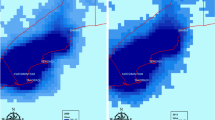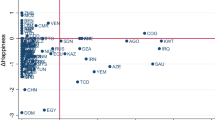Abstract
The paper empirically investigates the impact of natural resource abundance, in particular oil, on income disparities. It employs common correlated effects pooled mean group methodology for estimation to account for the cross-country heterogeneity and cross-section dependence in the oil-inequality nexus. In a sample of developed and developing countries, we find that oil abundance as well as oil dependence reduce income inequality. This inequality-reducing effect is highly likely to operate from better education attainments and improved health status due to oil booms.
Similar content being viewed by others
Notes
CCEMG and CCEPMG have been used to estimate the impact of government debt on economic growth (Eberhardt and Presbitero 2015), oil richness on economic development and growth (Cavalcanti et al. 2011), commodity price volatility on economic growth (Cavalcanti et al. 2015), and trade on economic growth and growth volatility (Kim et al. 2016), among many others.
It is noted that the concept of Granger causality is not equivalent to the notion of causation in the traditional sense of the word. Indeed, no econometric test can prove causation. Granger causality may best be thought of as a test of firstness rather than causation, so that if xGranger causes y then we have evidence that x precedes y. However, evidence in favor of Granger causality is certainly supportive of the notion that x causes y in the traditional sense (Dawson 2003).
Ideally, we would also like to include the cross-sectional averages of all the variables, but given that this is not possible, as we would run into lack of degrees of freedom, we choose the two variables that we believe are highly dependent across countries in our sample.
The Polity2 index measures a political regime by the polity score, which ranges from – 10 (strongly autocratic) to \(+\,10\) (strongly democratic). This measure reflects the degree of competitiveness in political participation, the openness and competitiveness in the selection of the legislature, and the constitutional constraints on executive powers. It also incorporates subjective information on checks and balances on executive powers, the degree of restrictions on electoral participation, and the extent to which political participation is regulated.
We find qualitatively similar results using oil exports. Our data on public education spending (% GDP), public health spending (% GDP), primary and secondary education enrollments, both total and female (% population), and infant and child mortality are sourced from WDI (2017).
References
Acemoglu D, Johnson S, Robinson JA (2002) Reversal of fortune: geography and institutions in the making of modern world income distribution. Quart J Econ 117:1231–1294
Acemoglu D, Robinson JA (2006) Economic origins of dictatorship and democracy. Cambridge University Press, Cambridge
Ades AF, Di Tella R (1999) Rents, competition, and corruption. Am Econ Rev 89:982–993
Alesina A, Devleescha A, Easterly W, Kurlat S, Wacziarg R (2003) Fractionalization. J Econ Growth 8:155–194
Arezki R, van der Ploeg F (2011) Do natural resources depress income per capita? Rev Dev Rev 15:504–521
Bahadir B, Valev N (2015) Financial Development Convergence. J Bank Finance 56:61–71
Benabou R (1996) Inequality and growth. In: Bernanke B, Rotemberg J (eds) National Bureau of economic research macroeconomics annual. MIT Press, Cambridge, pp 11–74
Boschini A, Pettersson J, Roine J (2013) The resource curse and its potential reversal. World Dev 43:19–41
Brown D, Hunter W (2004) Democracy and human capital formation: education spending in Latin America, 1980 to 1997. Comp Polit Stud 37:842–864
Brunnschweiler CN, Bulte EH (2008) The resource curse revisited and revised: a tale of paradoxes and red herrings. J Environ Econ Manag 55:248–264
Buccellato T, Mickiewicz T (2009) Oil and gas: a blessing for few hydrocarbons and within-region inequality in Russia. Eur-Asia Stud 61:385–407
Bumann S, Lensink R (2016) Capital account liberalization and income inequality. J Int Money Finance 61:143–162
Calderon C, Moral-Benito E, Serven L (2015) Is infrastructure capital productive? A dynamic heterogeneous approach. J Appl Econom 30:177–198
Carmignani T (2013) Development outcomes, resource abundance, and the transmission through inequality. Resour Energy Econ 35:412–428
Cavalcanti TVdV, Mohaddes K, Raissi M (2011) Growth, development and natural resources: new evidence using a heterogeneous panel analysis. Q Rev Econ Finance 51:305–318
Cavalcanti TVdV, Mohaddes K, Raissi M (2015) Commodity price volatility and the sources of growth. J Appl Econom 30:857–873
Chudik A, Mohaddes K, Pesaran MH, Raissi M (2013) Debt, inflation and growth: robust estimation of long-run effects in dynamic panel data models. CESifo Working Paper No. 4508
Chudik A, Pesaran MH (2015) Common correlated effects estimation of heterogeneous dynamic panel data models with weakly exogenous regressors. J Econom 188:393–420
Dawson JW (2003) Causality in the freedom–growth relationship. Eur J Polit Econ 19:479–495
El-Katiri L, Fattouh B, Segal P (2011) Anatomy of an oil-based welfare state: rent distribution in Kuwait. In: Held D, Ulrichsen K (eds) The transformation of the Gulf States: politics. Routledge, Economics and the Global Order, Abingdon
Eberhardt M, Presbitero A (2015) Public debt and growth: heterogeneity and non-linearity. J Int Econ 97:45–58
Engle RF, Granger CWJ (1987) Co-integration and error correction: representation, estimating and testing. Econometrica 55:251–276
Fum RM, Hodler R (2010) Natural resources and income inequality: the role of ethnic divisions. Econ Lett 107:360–363
Galbraith JK, Kum H (2005) Estimating the inequality of household incomes: a statistical approach to the creation of a dense and consistent global data set. Rev Income Wealth 51:115–143
Gimet C, Lagoarde-Segot T (2011) A closer look at financial development and income distribution. J Bank Finance 35:1698–1713
Goderis B, Malon SW (2011) Natural resource booms and inequality: theory and evidence. Scand J Econ 113:388–417
Gylfason T, Zoega G (2003) Inequality and economic growth: Do natural resources matter? In: Eicher T, Turnovsky S (eds) Inequality and growth: theory and policy implications. MIT Press, Cambridge, MA
Herzer D, Vollmer S (2012) Inequality and growth: evidence from panel cointegration. J Econ Inequal 10:489–503
Howie P, Atakhanova Z (2014) Resource boom and inequality: Kazakhstan as a case study. Resour Policy 39:71–79
Im KS, Pesaran MH, Shin Y (2003) Testing for unit roots in heterogeneous panels. J Econom 115:53–74
Kaufman RR, Segura-Ubiergo A (2001) Globalization, domestic politics, and social spending in Latin America. World Polit 53:553–87
Kim DH, Lin SC (2017a) Human capital and natural resource dependence. Struct Change Econ Dyn 40:92–102
Kim DH, Lin SC (2017b) Natural resources and economic development: new panel evidence. Environ Resour Econ 66:363–391
Kim DH, Lin SC, Suen YB (2016) Trade, growth and growth volatility: new panel evidence. Int Rev Econ Finance 45:384–399
Kocenda E (2001) Macroeconomic convergence in transition countries. J Comp Econ 29:1–23
Kose M, Prasad ES, Rogoff K, Wei S-J (2009) Financial globalization: a reappraisal. IMF Staff Pap 56:8–62
Leamer E, Maul H, Rodriguez S, Schott P (1999) Does natural resource abundance increase Latin American income inequality? J Dev Econ 59:3–42
Lopez-Feldman A, Mora J, Taylor E (2007) Does natural resource extraction mitigate poverty and inequality? Evidence from Rural Mexico and a Lacandona Rainforest Community. Environ Dev Econ 12:251–269
Lutkepohl H (2007) General-to-specific or specific-to-general modelling? An opinion on current econometric terminology. J Econom 136:319–324
Marchand J (2012) Local labor market impacts of energy boom–bust–boom in Western Canada. J Urban Econ 71:165–174
Mehlum H, Moene K, Torvik R (2012) Mineral rents and social development in Norway. In: Katja H (ed) Mineral rents and the financing of social policy. Palgrave Macmillan, Basingstoke
Meschi E, Vivarelli M (2009) Trade and income inequality in developing countries. World Dev 37:287–302
Parcero O, Papyrakis E (2016) Income inequality and the oil resource curse. Resour Energy Econ 45:159–177
Pedroni P (2004) Panel cointegration: asymptotic and finite sample properties of pooled time series tests with an application to the PPP hypothesis. Econom Theory 20:597–625
Pesaran MH (2004) General diagnostic tests for cross section dependence in panels. University of Cambridge, Faculty of Economics, Cambridge Working Papers in Economics No. 0435
Pesaran MH (2006) Estimation and inference in large heterogeneous panels with a multifactor error structure. Econometrica 74:967–1012
Pesaran MH (2007) A simple panel unit root test in the presence of cross-section dependence. J Appl Econom 22:265–312
Pesaran MH, Smith R (1995) Estimating long-run relationships from dynamic heterogeneous panels. J Econom 68:79–113
Pesaran MH, Shin Y, Smith RP (1999) Pooled mean group estimation of dynamic heterogeneous panels. J Am Stat Assoc 94:621–634
Ross M (2001) Does oil hinder democracy? World Polit 53:325–361
Ross M (2007) How mineral rich states can reduce inequality. In: Sachs JD, Stiglitz JE, Humphreys M (eds) Escaping the resource curse. Columbia University Press, New York
Ross M (2013) Oil and gas data, 1932–2011. Harvard Dataverse, V2. http://hdl.handle.net/1902.1/20369
Sachs JD, Warner AM (1995) Natural resource abundance and economic growth. National Bureau of Economic Research Working Paper 5398
Sachs JD, Warner AM (1999) The big push, natural resource booms and growth. J Dev Econ 59:43–76
Sokoloff KL, Engerman SL (2000) History lessons: institutions, factor endowments, inequality and paths of development among new world economies. J Econ Perspect 14:217–232
Solt F (2009) Standardizing the world income inequality database. Soc Sci Q 90:231–242
Steinberg D (2017) Resource shocks and human capital stocks: Brain drain or brain gain? J Dev Econ. doi:10.1016/j.jdeveco.2017.04.001
Urbain J-P (1992) On weak exogeneity in error correction models. Oxf Bull Econ Stat 54:187–207
van der Ploeg F (2011) Natural resources: Curse or blessing? J Econ Lit 49:366–420
Author information
Authors and Affiliations
Corresponding author
Additional information
We are grateful to Co-Editor, Eric Strobl, and anonymous referees for their very constructive comments and suggestions. The usual disclaimer applies.
Appendix: A Country List and Model Specification Tests
Appendix: A Country List and Model Specification Tests
Rights and permissions
About this article
Cite this article
Kim, DH., Lin, SC. Oil Abundance and Income Inequality. Environ Resource Econ 71, 825–848 (2018). https://doi.org/10.1007/s10640-017-0185-9
Accepted:
Published:
Issue Date:
DOI: https://doi.org/10.1007/s10640-017-0185-9




